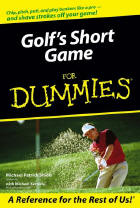Golf’s Short Game for Dummies
Reviewing golf books sometimes presents a semi-serious risk to the person doing it, especially if the reviewer is also an avid golfer.
It’s not a problem if the books are largely collections of pretty pictures, or biographies of one of the game’s greats.
It’s all those instruction manuals that are out there.
Eventually, the reviewer’s head is stuffed with a vast collection of playing tips, all competing for attention during a round of golf. Just before a difficult shot from under a tree, for example, there are at least three different options that come to mind, sometimes in the middle of the backswing.
This can be fatal to one’s performance, as I can tell you from repeated experience. At least, that’s one of the excuses I sometimes give myself for not yet carrying a single-digit handicap.
What helps reduce this risk, on the other hand, is an instruction book that presents its material in clear tones, with an upbeat message, and above all else, a constant reminder of the uncontrollable aspects of this sometimes frustrating game.
Michigan golf writer Michael Patrick Shiels and Florida club professional Michael Kernicki met this requirement in this wryly amusing, helpful guide to pitching, chipping, bunker play, and putting, in the now-familiar Dummies® format.
They frequently describe how so much of the final results of a given shot are subject to the whims and fancies of uncontrollable elements, such as knobby turf, gusts of wind, bits of mud stuck on the ball, and so forth. Essentially they tell their readers to enjoy the process of making a practiced attempt, without assuming perfect results will inevitably follow.
Without directly saying so, Shiels and Kernicki emphasize one of the paradoxes of a good short game–lowered assumptions about outcomes can actually lead to better scores. Here’s an example:
Goals are important, but achieving reasonable expectations for each short-game situation builds the confidence necessary to strive for the goals. If your expectations are too high, you may be constantly disappointed, which wrecks your self-image and confidence. ***
Work on your short game enough so that getting the ball on the green with one shot and then hitting no more than two putts is a reasonable expectation. If you consistently meet your expectation, holing a chip shot or hitting the ball close to the hole with one shot and only needing one putt becomes an attainable goal.
The introductory chapters and the segments on the four basic elements of the short game take up the first third or so of the book. The next several chapters should be the most useful for many golfers who already know the basics of the short game, but are looking for ways to deal with some of the relatively unusual situations that can arise within 25 yards or so from the green. Bump-and-runs, playing from cart paths, bellying the wedge, and other techniques are well-explained, as are the alternatives when those options don’t look like the best choices.
Shiels and Karnicki stress that these shots should and can be practiced, which is a point many golfers seem to not fully appreciate.
The last chapters include examples of short game wizardry from the professional tours, intended to inspire the rest of us. After all, not many amateurs can drive the ball 320 yards, but almost all of us can learn to putt and chip well.
Those who can’t play year-round sometimes wonder why their scores in October aren’t equaled when they play in late April or early May. If they paid careful attention to how they scored, these golfers might better understand that more practice time with the short game would help.
Even Dummies know this, and that’s why this book can help.
Review date: May 14, 2005


